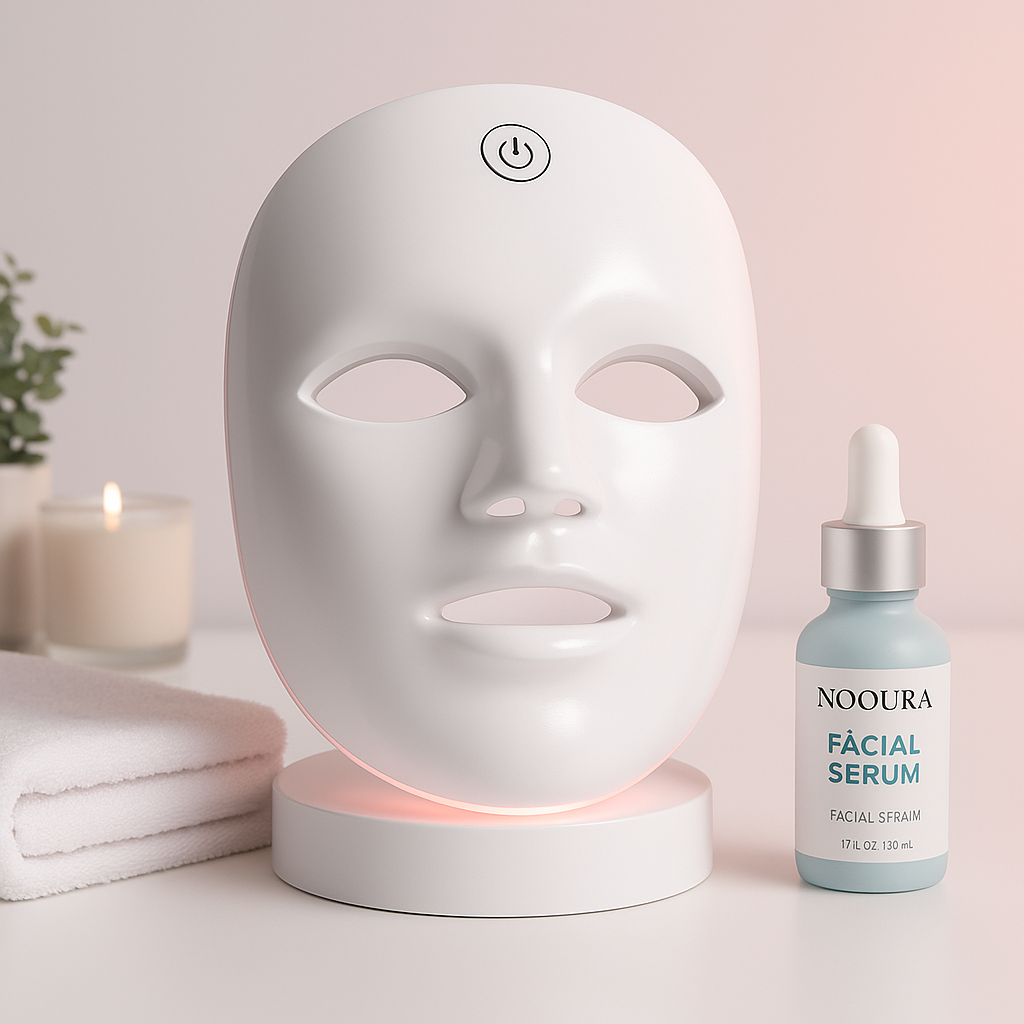In recent years, Red light therapy (RLT) — also known as photobiomodulation (PBM) — has become a popular topic in skincare and wellness. Many beauty brands now offer red light devices or claim that they improve skin health, anti-ageing, acne control, and more. But what does scientific research actually indicate? In this article, we'll explore how red light functions at the cellular level, what benefits are supported by studies, precautions, and how to incorporate it into your skincare regimen.
What Is Red Light Therapy?
- Red light therapy refers to exposure of your skin (or sometimes deeper tissues) to low-level red and/or near-infrared wavelengths (typically in the 600–900 nm range). Medical News Today+3ScienceDirect+3PubMed+3
- It is non-ionizing, does not burn like UV light, and does not destroy tissue. It aims to stimulate biological responses rather than cause damage. Medical News Today+2Cleveland Clinic+2
- Some devices use lasers; others use light-emitting diodes (LEDs). The effect is similar as long as the dosage and wavelength are appropriate. ScienceDirect+2PubMed+2
In the research community, this approach is often referred to as photobiomodulation (PBM). ScienceDirect+2PMC+2
How Red Light Affects Cells — Mechanisms of Action
To understand why red light might help skin, we need to look at how light interacts with cells. Some key mechanisms:
1. Mitochondrial Activation & ATP Production
One of the most accepted pathways is absorption of red/near-infrared photons by cytochrome c oxidase (CCO) in mitochondria. That can lead to:
- Release of nitric oxide (NO) from mitochondrial binding sites
- Increased mitochondrial respiration / oxygen consumption
- Higher production of adenosine triphosphate (ATP) — more cellular energy
- A mild, transient increase in reactive oxygen species (ROS), which in turn acts as signaling molecules (not damaging levels) PubMed+3PMC+3ScienceDirect+3
These changes can “wake up” or stimulate otherwise quiescent cells (e.g. fibroblasts, keratinocytes). Frontiers+2PMC+2
2. Anti-Inflammatory & Immunomodulation
Red light therapy can reduce inflammation via:
- Downregulating pro-inflammatory cytokines (e.g. TNF-α, IL-6)
- Modulating immune cell behavior (macrophage polarization, etc.) PMC+2Frontiers+2
- Upregulating antioxidant defenses and reducing oxidative stress in tissues PMC+2PubMed+2
3. Gene Expression & Protein Synthesis
Red light stimulates transcription factors and signaling cascades that lead to:
- Increased synthesis of extracellular matrix proteins: collagen, elastin, hyaluronic acid Frontiers+2PubMed+2
- Modulation of matrix metalloproteinases (MMPs) and their inhibitors (TIMPs), which regulate remodeling of tissue matrix Frontiers+1
- Enhanced DNA repair, cellular proliferation, migration, and survival signaling Frontiers+1
Together, these mechanisms contribute to the observable effects seen in skin (less wrinkles, better texture, healing) in various studies.
What Benefits Does Science Support?
While research is still emerging, several areas show promise. Let’s break them down:
| Use Case | Evidence / Findings | Caveats / Limitations |
|---|---|---|
| Skin Rejuvenation / Anti-Aging | Clinical trials have shown that red light can improve skin texture, reduce fine lines, and enhance complexion. Stanford Medicine+5PMC+5PubMed+5 | Many studies have small sample sizes or industry sponsorship. Protocols (dose, duration) vary widely. PubMed+1 |
| Acne & Inflammation | Some trials demonstrate reductions in acne lesions and sebum production with red light / combined red + blue light. ScienceDirect+3UCLA Health+3Medical News Today+3 | Effects tend to be mild to moderate. Not all acne types respond equally. |
| Hair Growth / Alopecia | Studies in androgenetic alopecia show increased hair density and thickness compared to baseline and controls. WebMD+2PubMed+2 | The response depends heavily on wavelength, dosing, and individual variation. Some meta-analyses call for stronger trials. PubMed+1 |
| Wound Healing / Repair | Red light can accelerate epithelial closure, collagen deposition, and re-epithelialization in wound models. Frontiers+1 | Translating animal or in vitro results to human skin in realistic settings can be complex. |
| Pain / Joint / Muscle Recovery | Some clinical studies show benefits in reducing pain, improving joint stiffness, especially for inflammatory or musculoskeletal conditions. WebMD+2PubMed+2 | The evidence is mixed; long-term effect sizes are not always robust. PubMed |
A recent review (The Clinical Applications of Low-Level Light Therapy) supports the idea that red/near-infrared light is a “safe and effective method” for skin rejuvenation, acne, alopecia, and body contouring — though it notes methodological weaknesses in some studies. PubMed
Also, an article from Stanford notes: “Overall, studies show that there’s benefit with hair growth, and there’s evidence to suggest it can reduce inflammation of tissues” — but emphasizes that treatment strength, wavelength, and duration matter. Stanford Medicine
Key Parameters That Impact Effectiveness
Getting red light therapy to work well depends heavily on “dosage” parameters. Here are some critical factors:
Wavelength / Spectrum
- 600–700 nm (visible red) and 700–900+ nm (near-infrared) are commonly used ranges. ScienceDirect+2PubMed+2
- Longer wavelengths penetrate more deeply (into dermis), but too long may reduce absorption by target chromophores. ScienceDirect+1
Fluence / Energy Density (Joules per cm²)
- Many aesthetic applications use doses up to ~15–20 J/cm². Frontiers
- There is a “biphasic dose response” — too low a dose may do nothing; too high may inhibit effects. PMC+2ScienceDirect+2
Irradiance / Power Density (mW/cm²)
- The power per area affects the duration needed. Higher irradiance can shorten session times but may also risk overheating or damage. ScienceDirect+1
Treatment Time & Frequency
- Many home-use regimens are ~5–20 minutes, several times per week. Medical News Today+3Health+3UCLA Health+3
- Clinical protocols often involve repeated sessions over weeks. Cleveland Clinic+2PubMed+2
Distance & Spot Size
- The distance between the light source and skin matters (too far reduces intensity).
- Uniform coverage is important to avoid under- or over-dosed areas.
Skin Type, Pigmentation & Individual Variation
- Skin tone, thickness, baseline health, and individual responsiveness can influence how much light actually penetrates and how cells respond.
- In darker skin, risks like hyperpigmentation should be monitored. UCLA Health+1
Safety, Risks & Limitations
While red light therapy is generally considered safe, there are some caveats:
- It does not use ultraviolet light (which causes DNA damage), so cancer risk is low. WebMD+1
- Overuse or very high doses can cause redness, swelling, or burns. WebMD+1
- Eye safety: red/infrared light can pose risks to the retina, so protective goggles are recommended when using devices near the eyes. Cleveland Clinic+1
- Long-term safety beyond months to a few years is less well studied. Cleveland Clinic+1
- Results vary between individuals; some may see little effect.
- Devices vary widely in quality, output, and credibility (some overhyped with weak parameters).
- People with photosensitivity conditions, on certain medications (e.g. photosensitizing drugs), or with certain skin conditions should consult a dermatologist first.
The American Academy of Dermatology notes that more controlled studies are needed, and users should be cautious, especially with home devices. AAD
How to Incorporate Red Light Therapy into Your Skincare Routine (for Beauty Brands / Consumers)
If your brand wants to incorporate or promote red light tools or skincare that complements red light, here’s a suggested approach (with disclaimers):
Select or design a high-quality device
- Use clinically backed wavelengths (e.g. ~630–670 nm, ~810–850 nm).
- Ensure energy output is in an effective but safe range (not underpowered or dangerously overpowered).
- Provide adequate cooling, spacing, and safety features (e.g. timers, eye protection).
Provide clear usage protocols
- Duration and frequency (e.g. 3–5 times per week, 10 minutes per session, rest days)
- Distance from skin, recommended skin states (clean, no heavy product barrier)
- Safety instructions (protect eyes, avoid broken skin, discontinue with irritation)
Complement with supporting skincare
- Use antioxidants (vitamin C, niacinamide) to help counter ROS and support repair
- Use hydrating / barrier-enhancing ingredients (hyaluronic acid, ceramides)
- Avoid photosensitizing actives (or use them at times when not using light)
Monitor and iterate
- Encourage customers to take “before & after” photos over weeks
- Offer guidance for tweaks (less time if over-response, more consistent usage)
- Provide disclaimers and suggest consulting dermatologists if uncertain
Educational content & transparency
- Share the science (like this blog) to build trust
- Be upfront about what is proven vs what is more speculative
- Recommend patch testing and safe use
Key Takeaways & Summary
- Red light therapy (photobiomodulation) is a promising, non-invasive method that uses red and near-infrared light to stimulate cellular processes.
- Its primary mechanism involves mitochondrial activation, leading to more ATP, release of nitric oxide, mild ROS signaling, and downstream modulation of gene expression and inflammation.
- Clinical evidence supports benefits in skin rejuvenation, acne, hair growth, and wound healing — but results are variable and many studies have limitations.
- Effectiveness critically depends on parameters: wavelength, dosage, frequency, and individual skin characteristics.
- It is relatively safe when used properly, but overuse or poor-quality devices can cause side effects.
- For a beauty brand, combining device + skincare + education + transparent claims is key to user trust and satisfaction.

